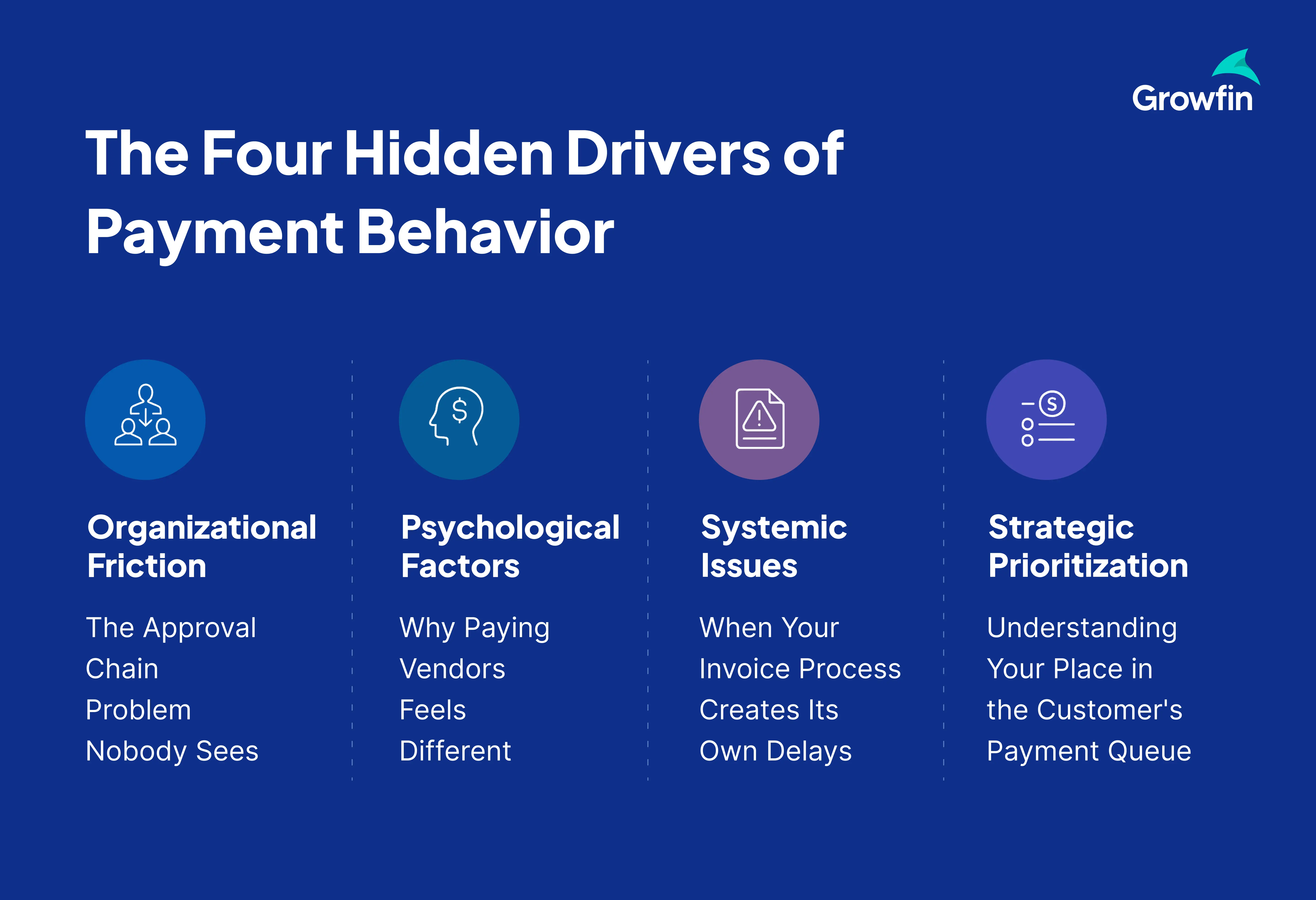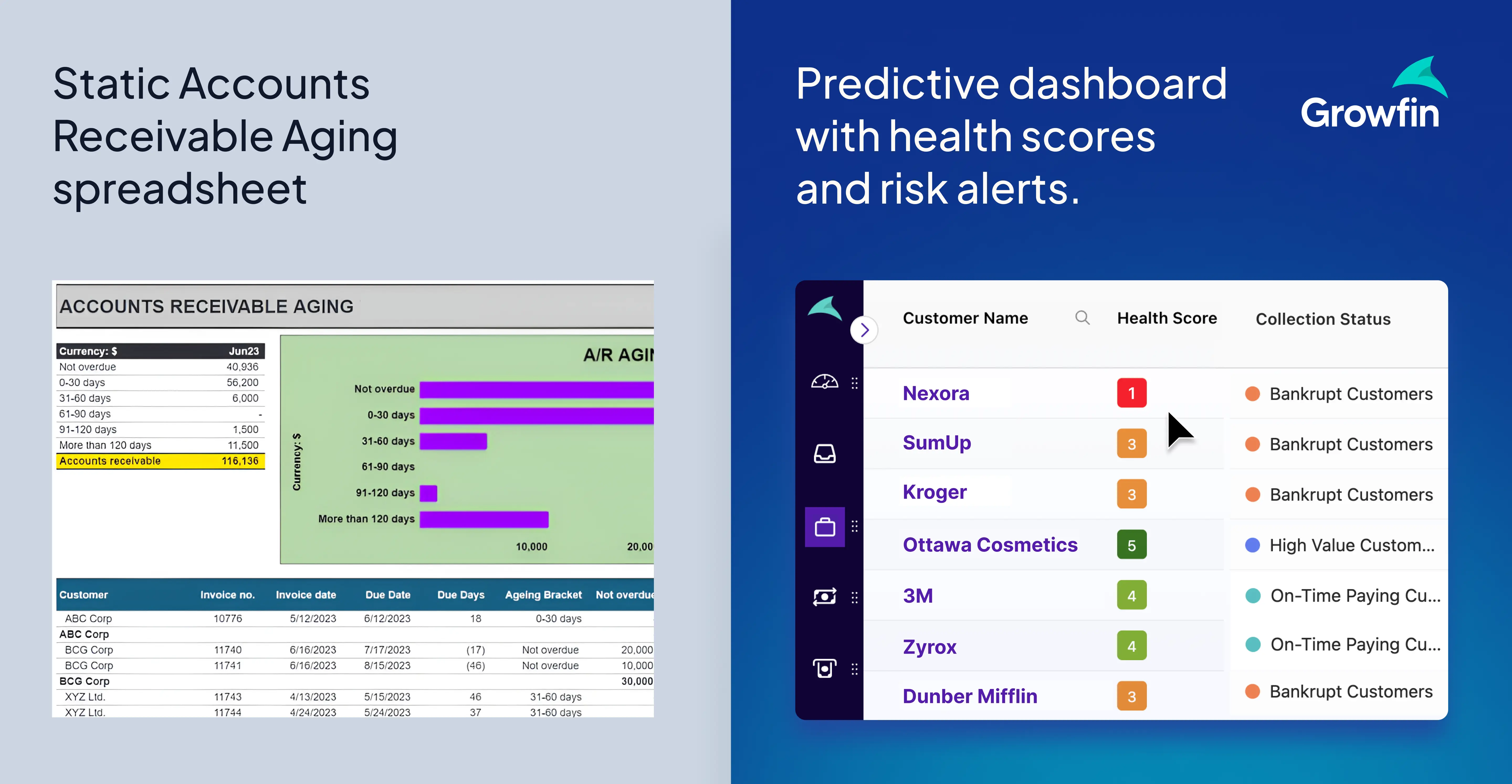The myth of random late payments
Ask any finance department why customers pay late and you'll frequently hear: "cash flow problems," "they're just slow payers," or "it's the economy." While these explanations are common, research and industry experience suggest payment delays are often shaped by internal processes and priorities—not simple financial hardship.
For example, even companies with excellent credit sometimes delay payments. Startups flush with capital can pay late, and organizations that pay some vendors promptly may habitually lag with others. The reason is rarely randomness—payment timing is usually the result of workflow, psychology, or strategic priorities, not cash constraints.
Imagine a hypothetical $100M company that pays logistics partners within 15 days but lets software invoices age 45–60 days. Same company, same finances, different behavior. Traditional AR processes often overlook these non-financial drivers.
Most AR teams treat payment timing like the weather: unpredictable and out of their hands. But research and AR data indicate it behaves more like traffic—there are patterns, rush hours, and slowdowns you can learn to anticipate.
The four hidden drivers of payment behavior
1. Organizational friction: the approval chain problem
Every invoice sets off an internal workflow that vendors often never see. At small companies, a single person may approve payments; at enterprises, a multi-tier process involving procurement, legal, finance, and the end-user is common.
Industry research shows every additional approval layer can significantly compound processing delays due to handoffs and competing priorities. Though not precisely quantified, workflow experts widely acknowledge this bottleneck.
Signals such as slower responses to invoice issues often indicate complex internal processes. When your primary contact suddenly goes quiet on payment, it's a sign the decision is moving to procurement or finance—teams with different priorities.
2. Psychological factors: why paying vendors feel different
B2B payments aren't purely transactional—the psychology of spend matters. Buyers tend to expedite payment for suppliers vital to their own revenue (like materials, logistics), while vendors perceived as overhead (e.g., SaaS, consultants) get deprioritized.
Sometimes, delayed payments serve as a passive "message" if a customer is dissatisfied—commonly referred to as the “payment-as-punishment” effect. Behavioral economics and customer experience studies support this as a form of informal feedback.

3. Systemic issues: SOPs and process
Invoice errors, mismatched purchase orders, and manual documentation are a leading source of delay—one frequently overlooked by AR teams. Industry research and AP providers agree that improper invoice formatting or missing details often triggers additional scrutiny, increasing processing times.
Successful AR teams conduct audits of their invoicing processes to remove friction, such as improving field accuracy, standardizing referencing, and ensuring digital process compatibility—all measures shown to speed up payments.
4. Strategic prioritization: are you a critical vendor?
Companies privately rank their suppliers, paying key partners first and deprioritizing less critical vendors, regardless of contractual net terms.
Your place in this hierarchy explains why payment patterns among customers diverge, and why simply sending more reminders rarely helps unless you can demonstrate higher business criticality.
Decoding the Digital Breadcrumbs
Today’s B2B buyers leave digital signals that help predict payment patterns. The key is knowing which ones to track.
Portal login patterns
Analysis by invoice portal providers indicates that portal engagement can be a leading early signal of payment behavior. For example:
- Regular logins without invoice downloads often signal internal process friction.
- One-time invoice downloads may reflect delegation to an approval chain.
- Repeated logins near due dates can indicate hesitancy, bottlenecks, or internal review cycles.
Email response timing
Accounts receivable teams use changes in email response speed as a practical predictive indicator. Quick replies (within 24–48 hours) often correlate with reliable, on-time payers; sudden delays can foreshadow workflow issues or shifting priorities.
Communication signals
If customers start copying new people or using language like “reviewing internally,” this typically indicates the invoice has entered a more complex approval process. Qualitative industry data point to a rising risk of delay at this stage.
The geography and timing of payments
Why location and industry matter
While every company is unique, sector and regional patterns in payment timing are well-documented—particularly across countries, industries, and regulatory regimes. For example:
- Companies in manufacturing hubs may schedule payments around production cycles.
- Venture-funded tech companies sometimes align supplier payments with tranche disbursements or fiscal quarters.
It’s best to derive localized insights from your own AR data, since sub-national payment patterns (e.g., East vs. West Coast) are less documented.
Day-of-week and holiday effects
Accounts payable automation vendors report that payment activity often peaks mid-week, with slower processing Mondays (catch-up) and Fridays (pre-weekend/travel).
However, this is not universal—your customer base may vary.
Payment velocity is also shaped by national and regional holidays: companies often accelerate payments prior to major holidays, or experience lags after. Local holidays and industry-specific calendars (e.g., construction “shutdown weeks”) also make a difference, especially for businesses with international exposure.
End-of-Month/Quarter Phenomena
Month- and quarter-end introduce competing payment pressures. Finance teams sometimes delay large invoice payments to a new reporting period to optimize cash flow, accelerate small invoice batching for closing efficiency, or otherwise adjust schedules to suit their business objectives.
From reactive to predictive: early warning signs
Seven practical early warning indicators
According to AR industry best practices, these signals can appear days or even weeks before payment delays reach your aging reports:
- Communication pace changes
- Portal login or usage shifts
- New recipients added to email threads
- Shift from logistical to procedural questions
- Change in preferred payment methods
- Seasonal or cyclical deviation from normal pattern
- Repeated requests for reference/P.O. numbers
Spotting "phantom delays"—invisible, but predictive
“Phantom delays” occur as processing stalls prior to invoice due dates and are best detected by changes in customer behavior—particularly when a previously prompt payer’s acknowledgment window stretches out. Many AR professionals use this observation as a reliable warning flag for impending payment bottlenecks.
Building customer payment profiles that work
Beyond tracking history, AR teams find that behavioral patterns (communication style, response speed, hints of approval chain length, and seasonal trends) are more predictive than payment history alone.
The 48-hour intervention window
AR practitioners report that the most effective interventions occur shortly before due dates—typically 3–5 days prior for accounts showing risk signals. Reaching out with proactive assistance (“Is there anything I can clarify?”) rather than warnings is more likely to prompt resolution. Industry consensus is that this approach frames the collection process as customer service, not pressure.
The reality check
Understanding payment psychology enables AR teams to be proactive, not just reactive. While it doesn’t eliminate late payments, it makes them more manageable and helps build customer relationships.

Reading digital and behavioral signals manually isn’t realistic at scale, but modern accounts receivable automation solutions aim to surface these patterns so teams can take timely action.
The future of accounts receivable isn’t about chasing harder, but about understanding your customers better.



.png)
.webp)


.webp)













.webp)




.webp)


.webp)
.webp)
.webp)
.webp)